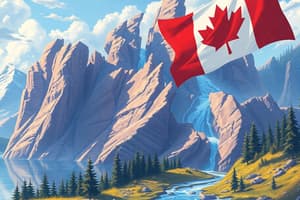Podcast
Questions and Answers
During which phase of Canadian federalism did the Judicial Committee of the Privy Council (JCPC) significantly strengthen provincial rights by weakening the Peace, Order, and Good Government (POGG) clause?
During which phase of Canadian federalism did the Judicial Committee of the Privy Council (JCPC) significantly strengthen provincial rights by weakening the Peace, Order, and Good Government (POGG) clause?
- Quasi-Colonial Federalism
- Classical Federalism (correct)
- Cooperative Federalism
- Emergency Federalism
Which period in the development of Canadian federalism saw the federal government assume extensive control over taxation and various industries, primarily to support war efforts?
Which period in the development of Canadian federalism saw the federal government assume extensive control over taxation and various industries, primarily to support war efforts?
- Emergency Federalism (correct)
- Cooperative Federalism
- Executive Federalism
- Classical Federalism
In the context of Canadian federalism, what was a defining feature of the Cooperative Federalism era?
In the context of Canadian federalism, what was a defining feature of the Cooperative Federalism era?
- Dominance of First Ministers’ Conferences in policy-making.
- Frequent use of federal disallowance powers over provincial laws.
- Increased provincial independence encouraged through Open Federalism.
- Shared taxation powers and cost-sharing arrangements between federal and provincial governments. (correct)
Which characteristic distinguishes Executive Federalism from other phases of Canadian federalism?
Which characteristic distinguishes Executive Federalism from other phases of Canadian federalism?
What is a key aspect of Collaborative & Open Federalism (1995-Present) in Canada?
What is a key aspect of Collaborative & Open Federalism (1995-Present) in Canada?
Which factor significantly contributed to political decentralization in Canada by expanding provincial powers through judicial interpretation?
Which factor significantly contributed to political decentralization in Canada by expanding provincial powers through judicial interpretation?
How did increased provincial fiscal power contribute to political decentralization in Canada?
How did increased provincial fiscal power contribute to political decentralization in Canada?
Which situation exemplifies the dynamics characteristic of Quasi-Colonial Federalism in Canada?
Which situation exemplifies the dynamics characteristic of Quasi-Colonial Federalism in Canada?
Which of the following was a primary consequence of provinces gaining taxation power in Canada?
Which of the following was a primary consequence of provinces gaining taxation power in Canada?
What was a key demand consistently made by Quebec regarding its relationship with the rest of Canada?
What was a key demand consistently made by Quebec regarding its relationship with the rest of Canada?
The Nisga'a Treaty of 1998 is a notable example of what?
The Nisga'a Treaty of 1998 is a notable example of what?
What impact did Ottawa's cuts to social program funding in the 1990s have on the provinces?
What impact did Ottawa's cuts to social program funding in the 1990s have on the provinces?
What key element of the Meech Lake Accord was intended to address Quebec's concerns?
What key element of the Meech Lake Accord was intended to address Quebec's concerns?
Which of the following best explains why the Charlottetown Accord ultimately failed?
Which of the following best explains why the Charlottetown Accord ultimately failed?
Which of the following is NOT a function of Canada's Constitution?
Which of the following is NOT a function of Canada's Constitution?
According to Canada's Constitution, which level of government has primary jurisdiction over education?
According to Canada's Constitution, which level of government has primary jurisdiction over education?
What is the significance of the '7/50 rule' in the context of Canadian constitutional law?
What is the significance of the '7/50 rule' in the context of Canadian constitutional law?
Which of the following best describes the 'Living Tree Doctrine' as it applies to the Canadian Constitution?
Which of the following best describes the 'Living Tree Doctrine' as it applies to the Canadian Constitution?
Flashcards
Quasi-Colonial Federalism
Quasi-Colonial Federalism
Highly centralized federal system where the federal government frequently used disallowance and reservation powers to override provincial laws.
Classical Federalism
Classical Federalism
A more balanced system where Judicial Committee of the Privy Council (JCPC) rulings strengthened provincial rights and weakened the federal POGG clause.
Emergency Federalism
Emergency Federalism
Federal government took over taxation and industries to fund war efforts, suspending provincial powers via War Measures Act.
Cooperative Federalism
Cooperative Federalism
Signup and view all the flashcards
Executive Federalism
Executive Federalism
Signup and view all the flashcards
Collaborative & Open Federalism
Collaborative & Open Federalism
Signup and view all the flashcards
Judicial Rulings Favoring Provinces
Judicial Rulings Favoring Provinces
Signup and view all the flashcards
Provincial Fiscal Power
Provincial Fiscal Power
Signup and view all the flashcards
Provincial Taxation Power
Provincial Taxation Power
Signup and view all the flashcards
Quebec's Demands
Quebec's Demands
Signup and view all the flashcards
Indigenous Self-Governance
Indigenous Self-Governance
Signup and view all the flashcards
Nisga'a Treaty (1998)
Nisga'a Treaty (1998)
Signup and view all the flashcards
Meech & Charlottetown Accords
Meech & Charlottetown Accords
Signup and view all the flashcards
The Constitution
The Constitution
Signup and view all the flashcards
Legislative Branch
Legislative Branch
Signup and view all the flashcards
Section 91
Section 91
Signup and view all the flashcards
Charter of Rights (1982)
Charter of Rights (1982)
Signup and view all the flashcards
Living Tree Doctrine
Living Tree Doctrine
Signup and view all the flashcards
Study Notes
- These notes cover the historical phases of Canadian federalism, explanations for political decentralization, the impact of the Meech Lake and Charlottetown Accords, and an overview of Canada's constitution.
Phases of Canadian Federalism
-
Canadian federalism has evolved through distinct stages, each marked by shifts in the balance of power between the federal and provincial governments.
-
These stages include Quasi-Colonial Federalism, Classical Federalism, Emergency Federalism, Cooperative Federalism, Executive Federalism, and Collaborative & Open Federalism.
-
Quasi-Colonial Federalism (1867-1896)
- Characterized by a highly centralized federal system.
- The federal government frequently used its powers of disallowance and reservation to override provincial laws.
- The Conservative government of John A. Macdonald favored a strong national government.
- An example includes Ottawa disallowing labor laws passed by Ontario and Quebec.
-
Classical Federalism (1896-1914)
- Marked by a greater balance between federal and provincial powers.
- Rulings by the Judicial Committee of the Privy Council (JCPC) strengthened provincial rights.
- The Peace, Order, and Good Government (POGG) clause was weakened, limiting its use to national emergencies.
- The Local Prohibition Case (1896) allowed provinces to regulate liquor sales, reducing federal power.
-
Emergency Federalism (WWI & WWII)
- The federal government assumed control over taxation and industries to fund war efforts.
- The War Measures Act was used in both World Wars to suspend provincial powers, expanding Ottawa’s control.
- In WWII, Ottawa regulated prices, controlled industries, and nationalized key sectors.
-
Cooperative Federalism (1930s-1995)
- Federal and provincial governments collaborated on social programs.
- Shared taxation powers and cost-sharing arrangements were established.
- The Medicare Act (1966) saw Ottawa funding 50% of provincial healthcare costs.
- Post-WWII social programs such as pensions, welfare, and education were developed.
-
Executive Federalism (1945-1995)
- Decision-making was dominated by First Ministers’ Conferences involving the Prime Minister and Premiers.
- Provinces gained more influence over federal policies.
- The 1982 Constitution negotiations were led by federal-provincial talks.
-
Collaborative & Open Federalism (1995-Present)
- Provinces gained more autonomy, particularly in areas like healthcare and education.
- The Social Union Framework Agreement (1999) limited federal spending power in provincial jurisdictions.
- Open Federalism, during the Harper era (2006-2015), encouraged greater provincial independence.
Explanations Behind Political Decentralization in Canada
-
Political decentralization in Canada has been driven by judicial rulings, increased provincial fiscal power, Quebec's nationalism, Indigenous self-governance movements, and federal debt and deficits.
-
Judicial Rulings Favoring Provinces
- JCPC rulings expanded provincial powers, weakening federal dominance.
- The Local Prohibition Case (1896) allowed provinces to regulate liquor sales, weakening Ottawa’s power.
-
Provincial Fiscal Power Increased
- Healthcare, education, and social welfare became primarily provincial responsibilities.
- Provinces gained taxation power, reducing their dependence on federal transfers.
-
Quebec’s Nationalism & Push for Autonomy
- Quebec consistently demanded special status and control over immigration, language, and culture.
- Quebec refused to sign the 1982 Constitution and demanded distinct society status.
-
Indigenous Self-Governance
- Indigenous groups demanded control over land, education, and self-rule.
- The Nisga’a Treaty (1998) granted self-governance and land rights to the Nisga’a Nation.
-
Federal Debt & Deficits
- Ottawa cut social program funding in the 1990s, forcing provinces to manage more responsibilities.
Meech Lake & Charlottetown Accords
-
The Meech Lake and Charlottetown Accords aimed to address concerns about decentralization but ultimately failed.
-
Meech Lake Accord (1987-1990)
- Proposed recognizing Quebec as a “distinct society”.
- Included a provincial veto over constitutional changes.
- Aimed to give more provincial control over immigration.
- Sought a greater provincial role in Supreme Court appointments.
- Failed due to opposition from Indigenous and Maritime groups.
-
Charlottetown Accord (1992)
- Sought to recognize Indigenous self-government.
- Proposed a Triple E Senate (Equal, Effective, Elected).
- Aimed to grant more provincial power over social programs.
- Sought to reduce federal intervention.
- Was rejected by voters (54% NO vote) due to regional disagreements.
Definition and Functions of the Constitution
-
The constitution is the fundamental law that defines government structure, powers, and citizens’ rights.
-
Canada’s Constitution is a mix of written and unwritten laws.
-
Defines Government Powers
- The legislative branch (Parliament) makes laws.
- The executive branch (PM, Cabinet) implements laws.
- The judicial branch (Supreme Court) interprets laws.
-
Outlines Federal-Provincial Division of Powers
- Section 91 (Federal) covers areas like defense, trade, and criminal law.
- Section 92 (Provincial) covers areas like education, healthcare, and property rights.
- Section 95 (Shared) covers areas like agriculture and immigration.
-
Protects Citizens’ Rights
- The Charter of Rights & Freedoms (1982) guarantees fundamental freedoms, legal rights, and equality rights.
-
Provides Amending Rules
- The 7/50 Rule requires Parliament plus 7 provinces (with 50% of the population) for amendments.
- Unanimous consent is required for changes to the monarchy, Senate, and language rights.
Sources of Constitutional Law
-
Written Sources
- The Constitution Act, 1867, created the federal system and divided powers.
- The Constitution Act, 1982, introduced the Charter of Rights and the amending formula.
- Organic Statutes are laws with quasi-constitutional status, such as the Bill of Rights 1960 and the Citizenship Act.
- British Statutes, like the Statute of Westminster (1931), ended British legislative control.
-
Judicial Rulings
- Supreme Court decisions interpret and shape the Constitution.
- The Living Tree Doctrine suggests the Constitution is flexible and evolving.
- The Famous Five Case (1930) recognized women as “persons” under the law.
-
Constitutional Conventions (Unwritten Laws)
- These are not legally binding but are followed in practice.
- The Governor General appoints the PM.
- The PM must resign if they lose a confidence vote.
Studying That Suits You
Use AI to generate personalized quizzes and flashcards to suit your learning preferences.




